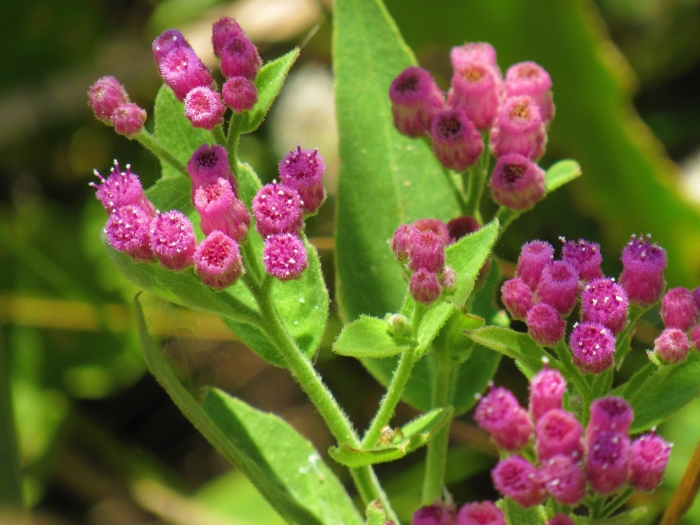Sweetscent
(Pluchea odorata)
Sweetscent (Pluchea odorata)
/
/

Joshua Liverman
CC BY 4.0
Image By:
Joshua Liverman
Recorded By:
Copyright:
CC BY 4.0
Copyright Notice:
Photo by: Joshua Liverman | License Type: CC BY 4.0 | License URL: http://creativecommons.org/licenses/by/4.0/ | Rights Holder: Joshua Liverman | Publisher: iNaturalist | Date Created: 2017-09-20T00:05:13-07:00 |


























































Estimated Native Range
Summary
Pluchea odorata, commonly known as Sweetscent, is a perennial herb that can be evergreen or semi-deciduous depending on the climate. It is native to wetland areas such as marshes and swamps in the Southern and East Coast United States, South and Central America, Mexico, and the Caribbean. This plant typically grows erect and can reach over one meter in height. Sweetscent is characterized by its large clusters of flower heads, each less than 1 cm (0.39 in) long, filled with bright pinkish-purple or magenta flowers that bloom in the summer and early fall. The fruit is a small achene topped with a bristly pappus, which aids in wind dispersal.
Sweetscent is valued for its aromatic foliage and showy flowers, which can add a splash of color to water gardens, rain gardens, and naturalized areas. It is also used in traditional medicine for various ailments. This plant thrives in full sun to full shade and prefers moist to wet soils with medium drainage. While it is adaptable to different light conditions, flowering is best in full sun. Gardeners should be aware that Pluchea odorata can spread aggressively by seed and may become invasive outside its native range. It is advisable to check local regulations before planting, as it may be considered a noxious weed in some areas.CC BY-SA 4.0
Sweetscent is valued for its aromatic foliage and showy flowers, which can add a splash of color to water gardens, rain gardens, and naturalized areas. It is also used in traditional medicine for various ailments. This plant thrives in full sun to full shade and prefers moist to wet soils with medium drainage. While it is adaptable to different light conditions, flowering is best in full sun. Gardeners should be aware that Pluchea odorata can spread aggressively by seed and may become invasive outside its native range. It is advisable to check local regulations before planting, as it may be considered a noxious weed in some areas.CC BY-SA 4.0
Plant Description
- Plant Type: Herb
- Height: 1.5-3 feet
- Width: 1.5-3 feet
- Growth Rate: Moderate
- Flower Color: Pink
- Flowering Season: Summer, Fall
- Leaf Retention: Evergreen, Semi-deciduous
Growth Requirements
- Sun: Full Sun, Part Shade, Full Shade
- Water: Medium, High
- Drainage: Medium
Common Uses
Butterfly Garden, Deer Resistant, Low Maintenance, Water Garden
Natural Habitat
native to wetland areas such as marshes and swamps in the Southern and East Coast United States, South and Central America, Mexico, and the Caribbean
Other Names
Common Names: Saltmarsh Fleabane , Shrubby Camphorweed , Marsh Fleabane
Scientific Names: Pluchea odorata , Pluchea purpurascens , Pluchea petiolata , Pluchea marilandica , Conyza odorata , Conyza angustifolia , Conyza purpurascens , Pluchea amorifera , Pluchea glabrata , Baccharis odorata
GBIF Accepted Name: Pluchea odorata (L.) Cass.